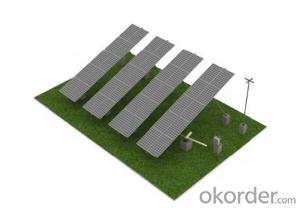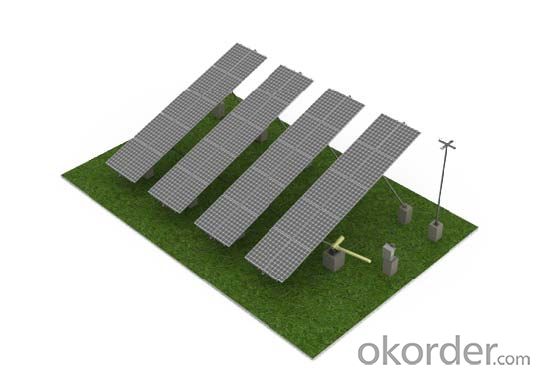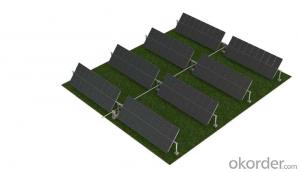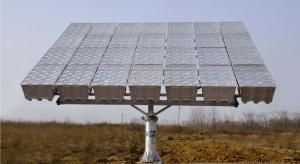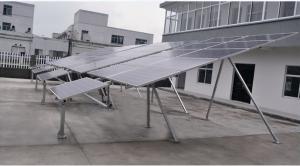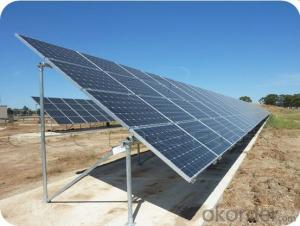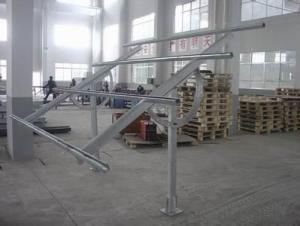Solar Energy Systems Llc Tilt Axis Tracking System Solar Mounting System
- Loading Port:
- China Main Port
- Payment Terms:
- TT OR LC
- Min Order Qty:
- -
- Supply Capability:
- -
OKorder Service Pledge
OKorder Financial Service
You Might Also Like
Packaging & Delivery
Packaging Detail:Normal package seaworthy
Delivery Detail:15 days
Specifications
Easy installation Competitive price TUV&SGS test report & CSA certification 15-warranty
Specifications
1) Super smooth beautiful appearance,outstanding quality,large supply.
2) Available in customized surface finishes.
3) Well machined,for example,cutting,drilling and milling with excellent tolerance.
4) Meet with customer’s designs and supply you best price.
5)Usages:Supply for solar panel modules.
Technical characteristics
Installation site:
ground,hillside,and grassland
Installation angle
it is based on customers’ requirements
Installation height
it is basedon customers’ requirements
Solar panel type; with or without frame
Components arrangement :horizontal or vertical
Support track
aluminum alloy extrusion
Quality warranty
15 years
Advantages
1)Quick installation: with high degree of pre-installed rate, the system could be easily installed by using galvanized carbon steel rails for PV Stent, and specially designed connection parts of the PV bracket, which could reduce installation time and cost greatly.
2)Offer unmatched durability: with all structural components comprised of high class stainless steel and anodized aluminum alloy, it is designed for 25 years service life and backed by 15 years warranty.
3)Stand up to extreme weather: The SuninTek solar mount is designed to stand up to the extreme weather complied with the AS/NZ 1170 and other international structure load standard by the skilled engineer. The main support components also have been tested to guarantee its structure and load-carrying capacity.
4)Provide broad installation flexibility: These systems accommodate most commercially available framed solar panels , and they can scale easily from small to large, multi-megawatt installations.
5)Diversified Application: The PV mounting system produced can be adopted by various types of PV cells panels which you can find in the market. It can serve for both mini solar power system and huge plant with megawatt capability.
Main features
1. Installation cost savings.
2. Save installation time.
3. Increase the mechanical strength of solar energy mounting to ensure that wind requirements.
4. The outdoor for installation of solar energy.
5. Length can be customized according to customers.
6. Service life of up to 25 years.
7. Products through the international certification.
8. Stent material composition of the galvanized steel and aluminum.
9. 15 years system and structural guarantee.
10.Flexible post spacing withstands different wind & snow loads.
11. High quality material in Aluminium 6005-T5 and SUS 304.
12.Screws and nuts go with every components needed.
13.Mechanical calculation and reliability tested to ensure highest product quality.
- Q: Can solar energy systems be leased or rented?
- Yes, solar energy systems can be leased or rented. Many companies offer leasing or rental options for solar panels and systems, allowing individuals and businesses to access the benefits of solar energy without the upfront costs of purchasing and installing the equipment.
- Q: Are there any limitations to using solar energy systems?
- Yes, there are a few limitations to using solar energy systems. Firstly, solar panels require sunlight to generate electricity, so their efficiency is dependent on weather conditions and geographical location. Cloudy or shaded areas may significantly reduce their output. Additionally, solar energy is intermittent and cannot be generated at night, requiring the use of batteries or grid connections for continuous power supply. Moreover, the initial installation cost of solar systems can be high, although it is generally offset by long-term savings. Finally, large-scale implementation of solar energy may require substantial land area, potentially impacting ecosystems and land use. However, advancements in technology and increasing affordability are continuously reducing these limitations.
- Q: Are there any maintenance costs associated with solar energy systems?
- Solar energy systems come with maintenance costs. Although solar panels require minimal maintenance compared to other energy systems, there are still expenses involved. These include regularly cleaning the panels for optimal efficiency, inspecting and repairing any damaged or malfunctioning components, and occasionally replacing worn-out parts. Moreover, monitoring and maintaining batteries or inverters that store and convert energy may be necessary. It is also advisable to have a professional conduct an annual inspection to ensure proper functioning. While these maintenance costs are generally low compared to the savings generated from solar energy, it is essential to consider them when analyzing the overall installation cost.
- Q: Can solar energy systems be used in areas with limited sunlight?
- Yes, solar energy systems can still be used in areas with limited sunlight. While solar panels may not generate as much electricity as they would in sunnier regions, they can still produce a significant amount of energy. Additionally, advancements in solar technology, such as the use of more efficient panels and energy storage solutions, have made it possible to harness solar power even in areas with less sunlight.
- Q: Can a solar energy system be installed on a parking garage or structure?
- Certainly, it is entirely possible to install a solar energy system on a parking garage or structure. As a matter of fact, these locations are often considered ideal for solar installations due to their expansive surface areas and access to sunlight. The utilization of available space can be maximized by mounting solar panels on the roof or external walls of parking structures. Furthermore, the raised position of parking garages enables better exposure to sunlight, resulting in more efficient generation of solar energy. Furthermore, the installation of a solar energy system on a parking garage or structure can yield numerous advantages, including the generation of clean and renewable energy, reduction in electricity costs, and offsetting of carbon emissions. This choice therefore proves to be a sustainable and environmentally friendly option for energy production.
- Q: Are there any environmental impacts associated with solar energy systems?
- Yes, solar energy systems have some environmental impacts, but they are significantly lower compared to traditional fossil fuel sources. The production and disposal of solar panels can generate some waste and emissions, but these are relatively minimal compared to the ongoing pollution caused by burning fossil fuels. Additionally, land use for large-scale solar installations can impact local ecosystems. However, proper planning and implementation can minimize these impacts, and the long-term benefits of solar energy in reducing greenhouse gas emissions and mitigating climate change far outweigh any potential negative environmental effects.
- Q: Can a solar energy system be installed in an apartment or rental property?
- Yes, a solar energy system can be installed in an apartment or rental property. However, there are a few considerations to keep in mind. Firstly, you need to check with your landlord or property owner to see if they are open to the idea of installing a solar energy system. Some landlords may be supportive of green initiatives and may even be willing to help with the installation costs. Others may have restrictions in place, so it is important to have a conversation with them before proceeding. Secondly, the feasibility of installing a solar energy system in an apartment or rental property will depend on the availability of suitable space for solar panels. In most cases, this would be the rooftop of the building. If the rooftop is shared among multiple tenants, you will need to discuss with them and obtain their consent as well. Additionally, it is important to consider the legal and financial aspects. You may need to consult with a solar energy contractor to assess the technical feasibility and cost of installation. Furthermore, you should investigate the laws and regulations in your area regarding solar installations on rental properties, as there may be specific requirements or permissions needed. Lastly, if you are a tenant, you need to consider the length of your lease. Installing a solar energy system is a long-term investment, and it may not be financially viable if you plan to move out before the system has paid for itself through energy savings. In summary, while it is possible to install a solar energy system in an apartment or rental property, it is important to have open communication with your landlord, consider the availability of suitable space, evaluate the legal and financial aspects, and consider the length of your lease before proceeding.
- Q: Can solar energy systems be installed in areas with heavy snowfall?
- Yes, solar energy systems can be installed in areas with heavy snowfall. However, it is important to consider the impact of snow on the system's performance and take necessary precautions during installation. Snow can temporarily reduce the amount of sunlight reaching the solar panels, which in turn reduces their energy production. However, the panels are designed to have a tilt and smooth surface, allowing snow to slide off easily. Additionally, advancements in technology have led to the development of snow-resistant solar panels that are more effective at converting sunlight into electricity even in snowy conditions. It is also worth noting that solar panels are often mounted at an angle to maximize their exposure to the sun, which helps to minimize snow accumulation. Overall, while heavy snowfall may impact the efficiency of solar energy systems, they can still be successfully installed and can contribute to renewable energy generation in areas with such climatic conditions.
- Q: Can solar energy systems be used in powering concert halls or auditoriums?
- Certainly, concert halls and auditoriums can make use of solar energy systems to generate power. The popularity of utilizing solar energy in large venues like these has been increasing due to its various advantages. The installation of solar panels on the roof or surrounding areas of the venue allows for the capture of sunlight and its conversion into electricity. This renewable energy source can then be used to power all the electrical equipment and lighting systems within the concert hall or auditorium. One of the main benefits of incorporating solar energy systems in these venues is the potential for cost savings. Concert halls and auditoriums typically consume substantial amounts of electricity, especially during events and performances. By harnessing solar power, these venues can significantly reduce their dependence on the traditional power grid and consequently lower their energy bills. Furthermore, solar energy systems require minimal maintenance once they are installed, which further contributes to their long-term cost-effectiveness. Furthermore, the integration of solar energy into concert halls and auditoriums aligns with the global emphasis on sustainability and the reduction of carbon footprints. By utilizing renewable energy sources such as solar power, these venues can considerably decrease their greenhouse gas emissions and promote a more environmentally friendly approach to energy consumption. This not only benefits the venue itself but also contributes to the overall sustainability goals of the local community and society as a whole. However, it is important to take into account that the size and power requirements of concert halls and auditoriums may necessitate a significant investment in solar panels and related equipment. Factors such as the venue's energy demand, available installation space, and the local climate all need to be assessed during the planning stage. Ensuring that the solar energy system is appropriately sized to meet the energy needs of the venue and designed to withstand the specific weather conditions of the location is crucial. In conclusion, it is indeed possible to use solar energy systems to power concert halls or auditoriums. The advantages of employing solar power in these venues encompass cost savings, environmental sustainability, and a reduction in reliance on the traditional power grid. With careful planning and installation, solar energy can provide a reliable and efficient source of electricity to meet the energy demands of such large-scale venues.
- Q: Can solar energy systems be used for powering telecommunications infrastructure?
- Yes, solar energy systems can be used to power telecommunications infrastructure. Solar panels can be installed on rooftops or in open spaces to harness sunlight and convert it into electricity. This renewable energy can then be used to power communication towers, equipment, and other telecommunications infrastructure, providing a sustainable and reliable energy source. Additionally, solar energy systems can be combined with battery storage solutions to ensure uninterrupted power supply even during periods of low sunlight or at night.
Send your message to us
Solar Energy Systems Llc Tilt Axis Tracking System Solar Mounting System
- Loading Port:
- China Main Port
- Payment Terms:
- TT OR LC
- Min Order Qty:
- -
- Supply Capability:
- -
OKorder Service Pledge
OKorder Financial Service
Similar products
Hot products
Hot Searches
Related keywords
